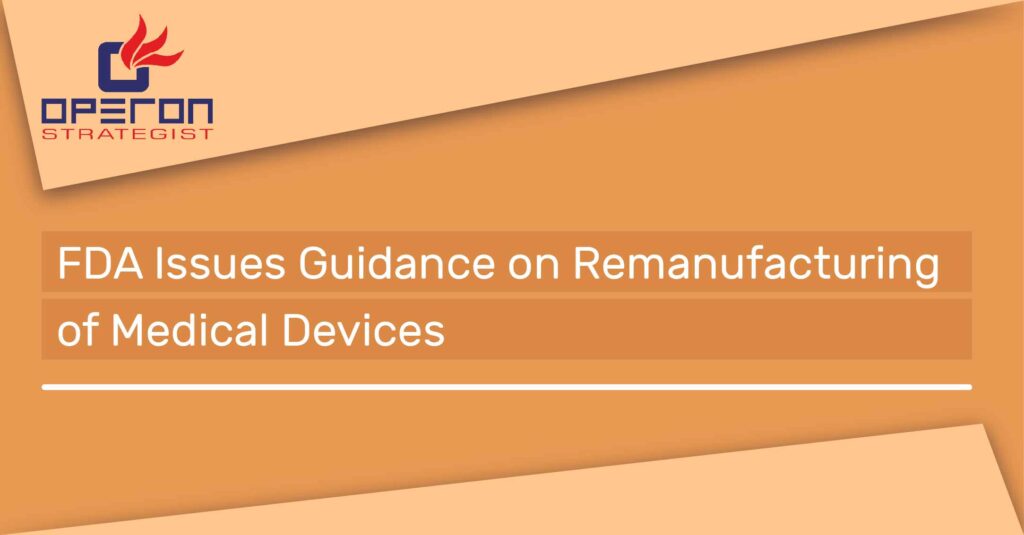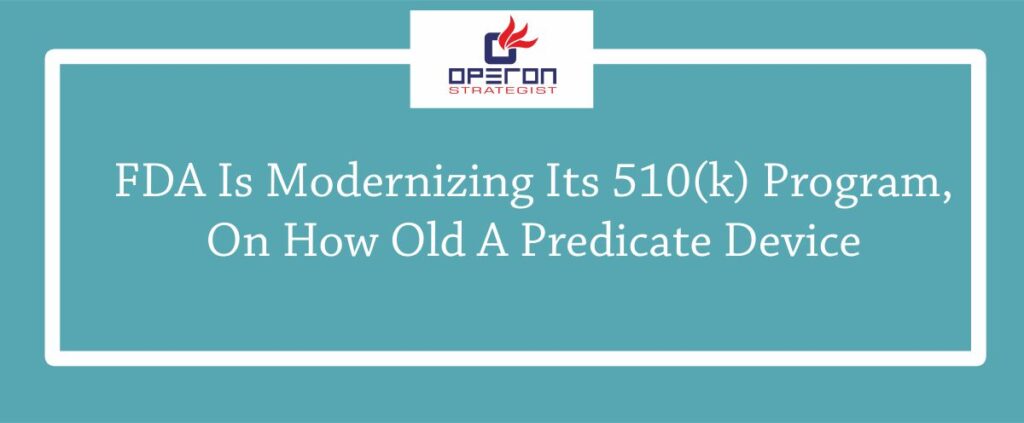FDA Issues Guidance on Remanufacturing of Medical Devices the Food and Drug Administration (FDA or Agency) is announcing the “Remanufacturing of Medical Devices.”A remanufacturer is defined as any person who processes, conditions, renovates, repackages, restores, or does any other act to a finished device that significantly changes the finished device\’s performance or safety specifications, or intended use.
A remanufacturer is defined as any person who processes, conditions, renovates, repackages, restores, or does any other act to a finished device that significantly changes the finished device\’s performance or safety specifications, or intended use.
- Operon Strategist is FDA 510 k process consultant helps the clients to register SBU (Small Business Unit), if applicable. Take out the testing requirement of the product, creation of the dossier, resolving the queries and after completion of all the activities, the client receives the US FDA 510 k approval.
- We also assist with the establishment registration and device listings to make suitable the supply of medical devices in the US.
FDA 510 k Clearance & Premarket Approval for Medical Device
Operon Strategist is FDA 510 k process consultant helps the clients to register SBU (Small Business Unit), if applicable. Take out the testing requirement of the product, creation of the dossier, resolving the queries and after completion of all the activities.
The availability of timely, cost-effective, quality maintenance and repair of medical devices is critical both to the successful functioning of the United States (U.S.) healthcare system and to the continued quality, safety, and effectiveness of marketed medical devices in the U.S.
This is very important for those devices used on numerous patients over long periods of time. Poor quality servicing may lead to poor device performance, device malfunction, and adverse events. Cybersecurity is also an important consideration in the servicing of medical devices.
The U.S. Food and Drug Administration (FDA) has released a draft guidance detailing the agency’s view of what constitutes a “remanufactured” medical device and to help clarify regulatory requirements applicable to such devices.
Remanufacturing of Medical Devices is the processing, conditioning, renovating, repackaging, restoring, or any other act done to a finished device that significantly changes the finished device’s performance or safety specifications, or intended use.5 There is no regulatory definition for the term “servicing,” but it is defined by the draft guidance as the “repair and/or preventive or routine maintenance of one or more parts in a finished device, after distribution, for purposes of returning it to the safety and performance specifications.
FDA Issues Guidance on Remanufacturing of Medical Devices these sets of (6) guiding principles to help determine whether the activities performed by an entity.
- Assess whether there is a change to the intended use.
- Determine whether the activities, individually and cumulatively, significantly change the safety or performance specifications of a finished device. FDA notes that it considers a “change” to also include activities that improve the device. Multiple changes, when considered together, may also significantly change the performance or safety specifications of the device and, as such, should be evaluated.
- Evaluate whether any changes to a device require a new marking submission in accordance with FDA’s guidance titled “Deciding When to Submit a 510(k) for a Change to an Existing Device.”8
- Assess component/part/material dimensional and performance specifications.
- Employ a risk-based approach to determine whether an activity significantly changes performance or safety specifications and should be considered manufacturing.
- Adequately document decision-making in order to help justify the firm’s decision-making in the event of an FDA inspection. Specifically, the documentation should specify why the activities performed on the device do or do not significantly change the performance or safety specifications, or intended use of the legally marketed device. FDA includes examples of such documentation in Appendix B of the draft guidance.
For purposes of the FDA Issues Guidance on Remanufacturing of Medical Devices, considers a significant change to device performance or safety specifications to be one that, “based on verification and validation testing and/or a risk-based assessment, results in a finished device that is outside the OEM’s performance or safety specifications or introduces new risks or significantly modifies existing risks.The draft guidance also includes a flowchart to help entities determine if an activity is likely manufacturing.
- adminhttps://operonstrategist.com/author/admin-2/
- adminhttps://operonstrategist.com/author/admin-2/
- adminhttps://operonstrategist.com/author/admin-2/
- adminhttps://operonstrategist.com/author/admin-2/




